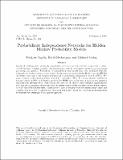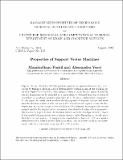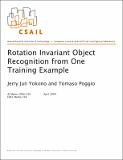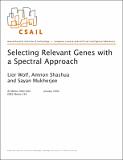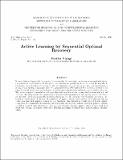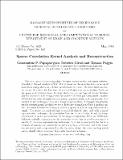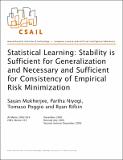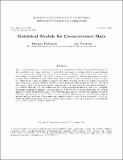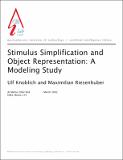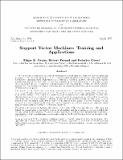Browsing CBCL Memos (1993 - 2004) by Title
Now showing items 89-108 of 123
-
Probabilistic Independence Networks for Hidden Markov Probability Models
(1996-03-13)Graphical techniques for modeling the dependencies of randomvariables have been explored in a variety of different areas includingstatistics, statistical physics, artificial intelligence, speech recognition, image ... -
Properties of Support Vector Machines
(1997-08-01)Support Vector Machines (SVMs) perform pattern recognition between two point classes by finding a decision surface determined by certain points of the training set, termed Support Vectors (SV). This surface, which in some ... -
The Quadric Reference Surface: Theory and Applications
(1994-06-01)The conceptual component of this work is about "reference surfaces'' which are the dual of reference frames often used for shape representation purposes. The theoretical component of this work involves the question ... -
Reciprocal Interactions Between Motion and Form Perception
(1995-04-21)The processes underlying the perceptual analysis of visual form are believed to have minimal interaction with those subserving the perception of visual motion (Livingstone and Hubel, 1987; Victor and Conte, 1990). ... -
Recognizing Indoor Scenes
(2001-07-25)We propose a scheme for indoor place identification based on the recognition of global scene views. Scene views are encoded using a holistic representation that provides low-resolution spatial and spectral information. The ... -
Relative Contributions of Internal and External Features to Face Recognition
(2003-03-01)The central challenge in face recognition lies in understanding the role different facial features play in our judgments of identity. Notable in this regard are the relative contributions of the internal (eyes, nose and ... -
Risk Bounds for Mixture Density Estimation
(2004-01-27)In this paper we focus on the problem of estimating a bounded density using a finite combination of densities from a given class. We consider the Maximum Likelihood Procedure (MLE) and the greedy procedure described by ... -
Role of color in face recognition
(2001-12-13)One of the key challenges in face perception lies in determining the contribution of different cues to face identification. In this study, we focus on the role of color cues. Although color appears to be a salient attribute ... -
Role of Low-level Mechanisms in Brightness Perception
(2001-08-01)Brightness judgments are a key part of the primate brain's visual analysis of the environment. There is general consensus that the perceived brightness of an image region is based not only on its actual luminance, but also ... -
Rotation Invariant Object Recognition from One Training Example
(2004-04-27)Local descriptors are increasingly used for the task of object recognition because of their perceived robustness with respect to occlusions and to global geometrical deformations. Such a descriptor--based on a set of ... -
Rotation Invariant Real-time Face Detection and Recognition System
(2001-05-31)In this report, a face recognition system that is capable of detecting and recognizing frontal and rotated faces was developed. Two face recognition methods focusing on the aspect of pose invariance are presented and ... -
Selecting Relevant Genes with a Spectral Approach
(2004-01-27)Array technologies have made it possible to record simultaneously the expression pattern of thousands of genes. A fundamental problem in the analysis of gene expression data is the identification of highly relevant genes ... -
Sequential Optimal Recovery: A Paradigm for Active Learning
(1995-05-12)In most classical frameworks for learning from examples, it is assumed that examples are randomly drawn and presented to the learner. In this paper, we consider the possibility of a more active learner who is allowed ... -
Slow and Smooth: A Bayesian Theory for the Combination of Local Motion Signals in Human Vision
(1998-02-01)In order to estimate the motion of an object, the visual system needs to combine multiple local measurements, each of which carries some degree of ambiguity. We present a model of motion perception whereby measurements ... -
Sparse Correlation Kernel Analysis and Reconstruction
(1998-05-01)This paper presents a new paradigm for signal reconstruction and superresolution, Correlation Kernel Analysis (CKA), that is based on the selection of a sparse set of bases from a large dictionary of class- specific basis ... -
Sparse Representations of Multiple Signals
(1997-09-01)We discuss the problem of finding sparse representations of a class of signals. We formalize the problem and prove it is NP-complete both in the case of a single signal and that of multiple ones. Next we develop a simple ... -
Statistical Learning: Stability is Sufficient for Generalization and Necessary and Sufficient for Consistency of Empirical Risk Minimization
(2002-12-01)Solutions of learning problems by Empirical Risk Minimization (ERM) need to be consistent, so that they may be predictive. They also need to be well-posed, so that they can be used robustly. We show that a statistical ... -
Statistical Models for Co-occurrence Data
(1998-02-01)Modeling and predicting co-occurrences of events is a fundamental problem of unsupervised learning. In this contribution we develop a statistical framework for analyzing co-occurrence data in a general setting where ... -
Stimulus Simplification and Object Representation: A Modeling Study
(2002-03-15)Tsunoda et al. (2001) recently studied the nature of object representation in monkey inferotemporal cortex using a combination of optical imaging and extracellular recordings. In particular, they examined IT neuron ... -
Support Vector Machines: Training and Applications
(1997-03-01)The Support Vector Machine (SVM) is a new and very promising classification technique developed by Vapnik and his group at AT&T Bell Labs. This new learning algorithm can be seen as an alternative training technique ...

